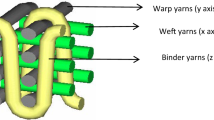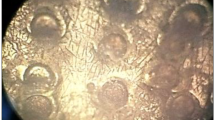Abstract
Disc cutter wear is a crucial problem that influences the working efficiency and security of hard rock tunnel-boring machines (TBMs). When tunneling and rock breaking with TBM, the cutters at the forefront of the cutter head directly contact the tunnel face, where wear is serious due to a harsh working environment. In this study, the Cerchar abrasivity index (CAI) of various rock samples was obtained by using the ATA-IGG I rock abrasion servo system. Additionally, a series of small-size cutter wear experiments were carried out on an SP3-I composite abrasion test platform, and the fitting relationship between cutter wear and rock abrasion value was obtained. A cutter wear prediction method was established by measuring the cutter wear and rock CAI of the project built section and the rock CAI of the project unbuilt section. Based on the experimental results, the effects of different tunneling parameters (penetration speed, rolling speed) and tip width on cutter wear were analyzed. In the study of cutter wear, attention should be paid to the influence of load, vibration and temperature on the cutter wear removal mechanism. It is suggested that wide-tip and narrow-tip cutters should be arranged alternately on a TBM cutter head to give full play to the lateral rock crack ability developed by the wide-tip cutter and the radial rock crack ability developed by the narrow-tip cutter, so as to reduce wear on the cutter and improve the efficiency of TBM rock breaking. The results of this research provide a reference for optimization design and performance selection of a TBM cutter ring and cutter head.












Similar content being viewed by others
References
Al-Ameen SI, Waller MD (1994) Influence of rock strength and abrasive mineral content on the Cerchar abrasive index. Eng Geol 36(3–4):293–301
Alber M (2008) Stress dependency of the Cerchar abrasivity index (CAI) and its effects on wear of selected rock cutting tools. Tunn Undergr Space Technol 23(4):351–359
Barzegari G, Uromeihy A, Zhao J (2015) Parametric study of soil abrasivity for predicting wear issue in TBM tunneling projects. Tunn Undergr Space Technol 48:43–57
Bruland A (1998) Hard rock tunnel boring. Ph.D. thesis, Norwegian university of Science and Technology
Capik M, Yilmaz AO (2017) Correlation between Cerchar abrasivity index, rock properties, and drill bit lifetime. Arab J Geosci 10(1):15
Cho JW, Jeon S, Jeong HY, Chang SH (2013) Evaluation of cutting efficiency during TBM disc cutter excavation within a Korean granitic rock using linear-cutting-machine testing and photogrammetric measurement. Tunn Undergr Space Technol 35(4):37–54
Deliormanlı AH (2012) Cerchar abrasivity index (CAI) and its relation to strength and abrasion test methods for marble stones. Constr Build Mater 30:16–21
Er S, Tuğrul A (2016) Estimation of Cerchar abrasivity index of granitic rocks in Turkey by geological properties using regression analysis. Bull Eng Geol Environ 75(3):1325–1339
Espallargas N, Jakobsen PD, Langmaack L, Macias FJ (2014) Influence of corrosion on the abrasion of cutter steels used in TBM tunnelling. Rock Mech Rock Eng 48(1):261–275
Farrokh E, Kim DY (2018) A discussion on hard rock TBM cutter wear and cutterhead intervention interval length evaluation. Tunn Undergr Space Technol 81:336–357
Geng Q, Wei Z, Meng H (2016) An experimental research on the rock cutting process of the gage cutters for rock tunnel boring machine (TBM). Tunn Undergr Space Technol 52:182–191
Gertsch R, Gertsch L, Rostami J (2007) Disc cutting tests in Colorado Red Granite: implications for TBM performance prediction. Int J Rock Mech Min Sci 44(2):238–246
Hassanpour J (2018) Development of an empirical model to estimate disc cutter wear for sedimentary and low to medium grade metamorphic rocks. Tunn Undergr Space Technol 75:90–99
Hassanpour J, Rostami J, Tarigh Azali S, Zhao J (2014) Introduction of an empirical TBM cutter wear prediction model for pyroclastic and mafic igneous rocks; a case history of Karaj water conveyance tunnel. Iran Tunn Undergr Space Technol 43:222–231
Ko TY, Kim TK, Son Y, Jeon S (2016) Effect of geomechanical properties on Cerchar abrasivity index (CAI) and its application to TBM tunnelling. Tunn Undergr Space Technol 57:99–111
Köppl F, Thuro K, Thewes M (2015) Suggestion of an empirical prognosis model for cutting tool wear of Hydroshield TBM. Tunn Undergr Space Technol 49:287–294
Lin L, Mao Q, Xia Y, Zhu Z, Yang D, Guo B, Lan H (2017) Experimental study of specific matching characteristics of tunnel boring machine cutter ring properties and rock. Wear 378–379:1–10
Liu Q, Liu J, Pan Y, Zhang X, Peng X, Gong Q, Du L (2017) A wear rule and cutter life prediction model of a 20-in. TBM cutter for granite: a case study of a water conveyance tunnel in China. Rock Mech Rock Eng 50:1303–1320
Ma H, Gong Q, Wang J, Yin L, Zhao X (2016) Study on the influence of confining stress on TBM performance in granite rock by linear cutting test. Tunn Undergr Space Technol 57:145–150
Macias FJ, Dahl F, Bruland A (2016) New rock abrasivity test method for tool life assessments on hard rock tunnel boring:the Rolling Indentation Abrasion Test (RIAT). Rock Mech Rock Eng 49(5):1–15
Macias FJ (2016) Hard rock tunnel boring: performance predictions and cutter life assessments. Ph.D. thesis, Norwegian university of Science and Technology
Mahdevari S, Shahriar K, Yagiz S, Akbarpour Shirazi M (2014) A support vector regression model for predicting tunnel boring machine penetration rates. Int J Rock Mech Min Sci 72:214–229
Majeed Y, Bakar MZA (2015) Statistical evaluation of CERCHAR Abrasivity Index (CAI) measurement methods and dependence on petrographic and mechanical properties of selected rocks of Pakistan. Bull Eng Geol Environ 75(3):1–20
Michalakopoulos TN, Anagnostou VG, Bassanou ME, Panagiotou GN (2006) The influence of steel styli hardness on the Cerchar abrasiveness index value. Int J Rock Mech Min Sci 43(2):321–327
Petrica M, Badisch E, Peinsitt T (2013) Abrasive wear mechanisms and their relation to rock properties. Wear 308(1–2):86–94
Plinninger R, Käsling H, Thuro K, Spaun G (2003) Testing conditions and geomechanical properties influencing the CERCHAR abrasiveness index (CAI) value. Int J Rock Mech Min Sci 40(2):259–263
Ren DJ, Shen SL, Zhou A, Chai JC (2018) Prediction of lateral continuous wear of cutter ring in soft ground with quartz sand. Comput Geotech 103:86–92
Rostami J (1997) Development of a force estimation model for rock fragmentation with disc cutters through theoretical modeling and physical measurement of crushed zone pressure. Ph.D, Colorado School of Mines, Golden, Colorado, USA
Teymen A (2020) The usability of Cerchar abrasivity index for the estimation of mechanical rock properties. Int J Rock Mech Min Sci 128:104258
Wang L, Kang Y, Cai Z, Zhang Q, Zhao Y, Zhao H, Su P (2012) The energy method to predict disc cutter wear extent for hard rock TBMs. Tunn Undergr Space Technol 28:183–191
Wang L, Kang Y, Zhao X, Zhang Q (2015) Disc cutter wear prediction for a hard rock TBM cutterhead based on energy analysis. Tunn Undergr Space Technol 50:324–333
Wang L, Li H, Zhao X, Zhang Q (2017) Development of a prediction model for the wear evolution of disc cutters on rock TBM cutterhead. Tunn Undergr Space Technol 67:147–157
West G (1989) Rock abrasiveness testing for tunnelling. Int J Rock Mech Min Sci 26(2):151–160
Wijk G (1992) A model of tunnel boring machine performance. Geotech Geol Eng 10(1):19–40
Yaralı O, Yaşar E, Bacak G, Ranjith PG (2008) A study of rock abrasivity and tool wear in Coal Measures Rocks. Int J Coal Geol 74(1):53–66
Zhang X, Xia Y, Zhang Y, Tan Q, Zhu Z, Lin L (2017) Experimental study on wear behaviors of TBM disc cutter ring under drying, water and seawater conditions. Wear 392–393:109–117
Zhang X, Lin L, Xia Y, Tan Q, Zhu Z, Mao Q, Zhou M (2018) Experimental study on wear of TBM disc cutter rings with different kinds of hardness. Tunn Undergr Space Technol 82:346–357
Zhang GZ, Konietzky H, Song ZY, Zhang M (2020) Study of Cerchar abrasive parameters and their relations to intrinsic properties of rocks for construction. Constr Build Mater 244:118327
Zhao Y, Yang H, Chen Z, Chen X, Huang L, Liu S (2019) Effects of jointed rock mass and mixed ground conditions on the cutting efficiency and cutter wear of tunnel boring machine. Rock Mech Rock Eng 52:1303–1313
Funding
The research was supported by the High Speed Railway and Natural Science United Foundation of China (U1934213), the General Program of the National Natural Science Foundation of China (51878572 and 51678503).
Author information
Authors and Affiliations
Corresponding author
Additional information
Publisher's Note
Springer Nature remains neutral with regard to jurisdictional claims in published maps and institutional affiliations.
Rights and permissions
About this article
Cite this article
Zhang, Z., Zhang, K. & Dong, W. Experimental Investigation on the Influence Factors on TBM Cutter Wear Based on Composite Abrasion Test. Rock Mech Rock Eng 54, 6533–6547 (2021). https://doi.org/10.1007/s00603-021-02621-w
Received:
Accepted:
Published:
Issue Date:
DOI: https://doi.org/10.1007/s00603-021-02621-w




